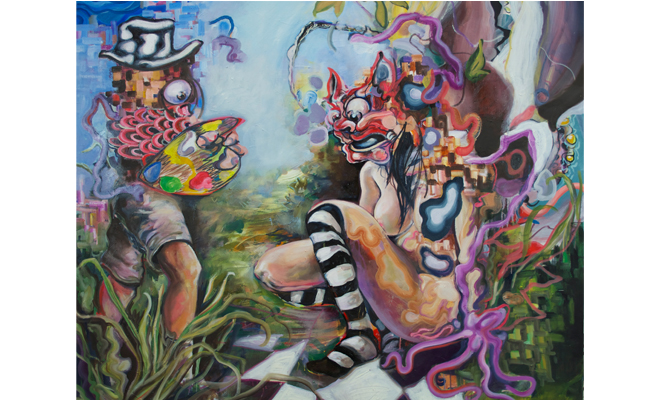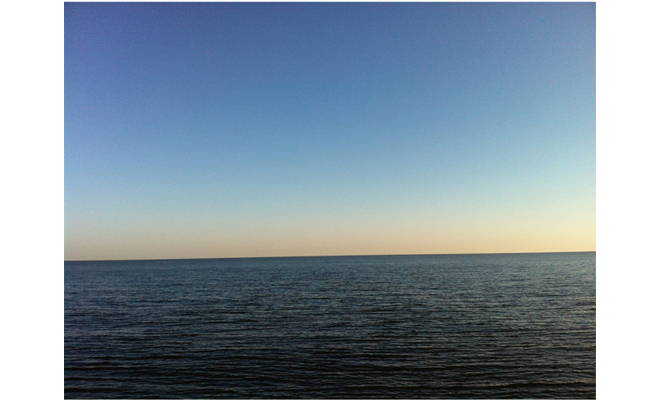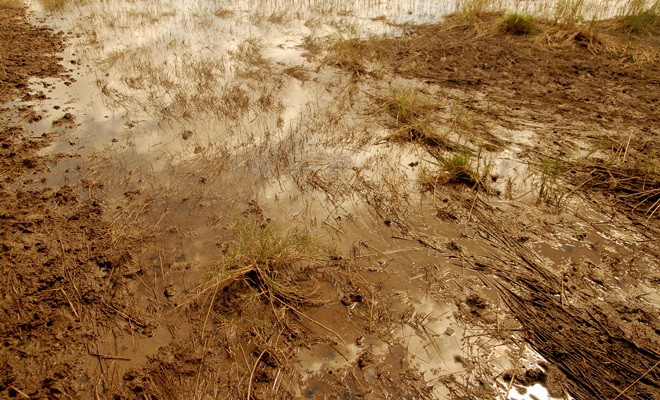Art Fly: St. Claude November Openings

Ron Bennett, Painter and Mutating Model, 2012. Oil on canvas. Courtesy the artist.
Editor's Note
She’s ba-ack! Got a weekend of gallery hopping lined up? Resident art fly Rachel Gorman reports on what she saw last Saturday on St. Claude.
Hold on to your hats, New Orleans. It’s the second installment of Art Fly, and this time I journeyed to the center of the gallery openings on St. Claude Avenue for a seen-and-heard column you’ll remember forever…or at least, until next time.
I headed first to Ron Bennett’s “RE/Evolve” show at the New Orleans Healing Center, whose Second Story Gallery is the most recent addition to the St. Claude collective scene, congratulating myself along the way for the strategic decision to start my tour with the gallery I felt I was most likely to find organic falafel—I did not. I did, however, find a crowd dressed like yogis who you would _expect _to be eating that kind of thing, milling around inside the lobby. “Here for the art?” I asked, holding the elevator door open for a longhaired couple that was walking by. Longhaired Guy rolled his eyes, “We’re taking the stairs.”
Riding the elevator (and a wave of guilt about my energy consumption), I made it to the second floor of the Healing Center where Bennett’s large, colorful canvases were impossible to miss. His works feature expressively rendered subjects (tentacled aliens, nude earth-mother types, enormous eyeballs, or some figural combination of all three) interacting with one another in extraterrestrial, swampy landscapes. His stripes, checks, and swaths of solid color surround and envelop his subjects like slime, somehow whimsically evoking the same kind of viscosity previously reserved for oil spill disasters and creepy animated villains. Small, absurd statements, meant to suggest that a larger narrative tied the show together, were positioned next to each canvas. One example, accompanying Bennett’s Painter and Mutating Model, read:
Gowgin dedicated the rest of his time to smearing colored dirt onto flat surfaces in the depiction of the native mutants.
Meta, I thought. Bennett’s seemingly Avatar-inspired paintings are not my thing, but I can always appreciate an artist that keeps it funny. Standing around chuckling in the gallery made me realize though: I still had serious ground to cover! It was back down the elevator and on to the next show.
Down the street at the UNO St. Claude Gallery, there wasn’t a yogi to be found. What the gallery lacked in long scarves and beads, it more than made up for in 20-something hipsters dressed in au courant “dorky dad” outfits and dad-aged men that actually looked pretty hip. Young and old, these people were LOUD. Everyone was drinking, and seemed to have decided (perhaps not coincidentally) that jokes were most funny when shouted across a room. I noted the party atmosphere and, when I approached the bar, the empty bottle of Jameson I had clearly come too late to partake in. So much for the strategic portion of my gallery-hopping plan. Next time, I swore to myself, I would be planning this trek a little differently.
At the UNO St. Claude Gallery, a show of photographs called “Adjust + Adapt” was presented by the all-female New Orleans collective Southerly Gold. The opening showcased stunning shots of people, things, and places all undergoing some processes of transition and transformation.

Ariya Martin, 10/17/12, 8:11:54 AM + 4:33:32 PM (detail), 2012. Archival pigment print. Courtesy the artist.
The first work I checked out, Elena Ricci’s series The East, depicts dilapidated school buses, abandoned furniture, and trailers overgrown with weeds. Ricci’s photos, their deep green rural landscapes punctuated by bright, solitary objects, were beautiful. Her color palate also offset Ariya Martin’s photographs in This Is Water that hung together like blue and grey jewels on a wall nearby. Taken over the course of a month from what looks like roughly the same vantage point on the shore, Martin’s pictures chronicle a changing coastal environment. Individually, the images are not that spectacular—they fail to pack the same punch one might feel when seeing the landscape in person, which is perhaps in itself a comment on the relationship between the medium and experience. Presented as a series, however, the differences between them become their dynamism, and together they indeed confront, what Martin calls the “vastness of sky and water.”
Concerning a different kind of confrontation was the third photographer in Southerly Gold: Akasha Rabut and her series, John McDonogh High. In her photographs, Rabut looks inside the lives of New Orleans charter school students attending what was once one of the most violent public high schools in the country. The teenagers proudly face the camera, dressed in uniforms that hint at a myriad of personal interests: sports jerseys, leotards, cheerleading outfits, a suit. Each projecting an interior universe of individual motivations and personality traits, the teens pictured are linked by at least one commonality: they attend John McDonogh High yet seem defiantly determined to remain undefined by that experience alone.
The final photographs I checked out at UNO St. Claude Gallery, Aubrey Edwards’ Pointe Aux Chenes, were works that depict Southern Louisiana landscapes and their inhabitants. Her images, awash in bright white lighting and sepia-toned brown, are made by their context: the real danger that the land and culture pictured will soon quite literally melt into the Gulf of Mexico. Armed with that knowledge, images I might have otherwise found banal—a man holding an alligator head, women’s tattooed legs, an office with a mounted deer head in its corner—felt steeped in tragedy and suddenly very profound. At one point, I was so moved by the heartbreak inherent in Edwards’ pictures, that I welled up over what, in hindsight, was essentially a close-up shot of a Louisiana mud puddle. Luckily, I regained my composure and ducked out the door before any of those dad-types could try to comfort me with an old hanky and a stiff pat on the back.
So that’s it once again, your Saturday night St. Claude gallery recap. I laughed, I cried, I held an elevator door open for hippies who mocked me. After such an epic art adventure, what more could you ask for? Actually, a lot. There were a ton of openings all along St. Claude, but not to worry, dear readers! I’m still on the case so all that really means is that there’s plenty of stuff I can cover next. Like what, you might ask? There’s only one way to find out…

Aubrey Edwards, Burial Mound, 2012. Digital print. Courtesy the artist.



